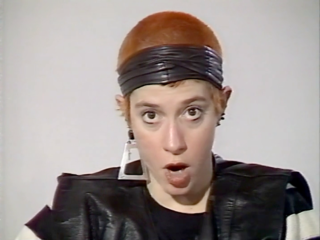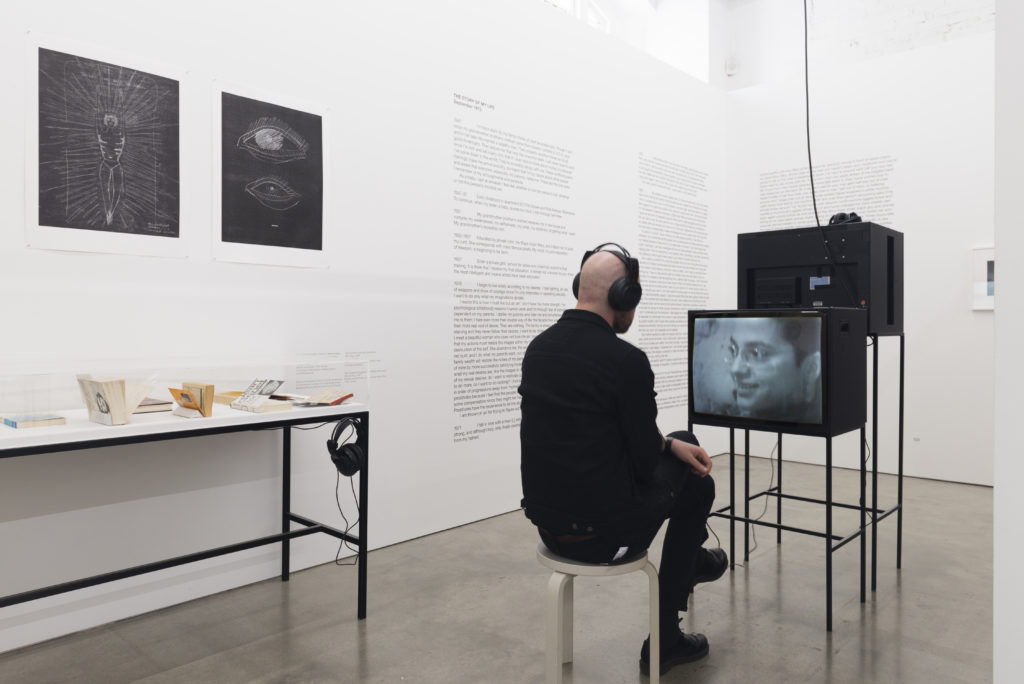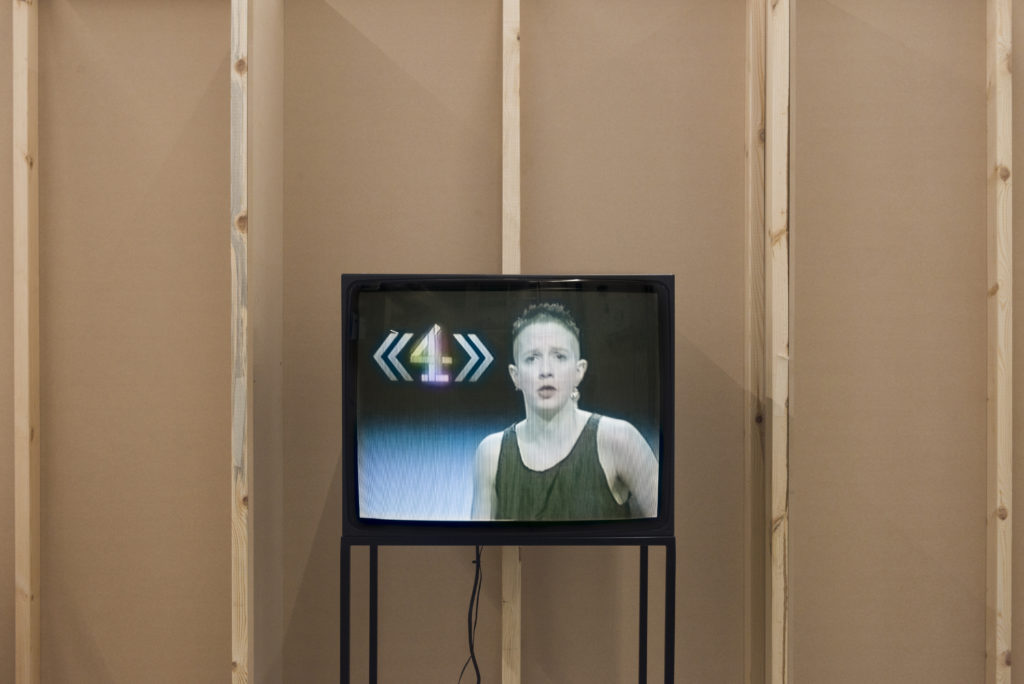I,I,I,I,I,I,I, Kathy Acker: ICA, London
by Rafael Powell
“I’m always destroying,” the late Kathy Acker said in an interview at the Institute of Contemporary Arts, London (ICA) in 1986, “To hell with the word deconstructing. I’m always destroying, you know, rigidities, habitual meanings, habitual contents.” Coming full circle from that interview, I,I,I,I,I,I,I, Kathy Acker, the first UK exhibition dedicated to her work at the ICA, explores the career of one of the most controversial writers of the last half a century. Bringing together a collection of Acker’s writings, her collection, and various responses, the exhibition is loosely divided into eight sections, each corresponding to one of Acker’s large works.
Displayed so that each work leads into the next—the divisions loose and permeable—the exhibition flows easily from section to section, mirroring her unrestricted writing style. Acker was a prose writer and poet; her work is at times Post-Modern, in that it rejected Modernist ideals, constraints, and styles, and often Post-structuralist, as it uprooted conventional construction of text. In 1966, she wrote that she worked with a language that created connections where there were none, language ‘that makes webs.’ Much like writer Hakim Bey’s notion of a “Counter-Net”,1 which grows in the in-between spaces of the Net, one can imagine Acker’s language web as operating in the spaces between formal language. In this, the web of meaning is less tangible, more susceptible to multiple interpretations, “…as if Net were a fishing-net and the Web were spider-webs woven through interstices and broken sections of the Net.”2

By exploiting subversions of language, Acker simultaneously explored contradictions in presupposed definitions, including the definitions of identity. In a recorded reading of Hello, I’m Erica Jong (1982) Acker writes from the perspective of American author Erica Jong, whose work laid many of the foundations of second-wave feminism. Acker’s Erica Jong, however, is an amalgamation of various feminine tropes or assumptions. Acker’s Erica is at once sexual predator and victim, using her child-like outlook to coax sexual attraction. She is at once sexual archetype, object of Acker’s scorn, a manifestation of Acker herself. “I’m a real writer now,” reads Acker in a baby-voice with exaggerated puckered lips, raised eyebrows and widened-doe eyes, “My name is Erica Jong. I’d rather be a baby than have sex. I’d rather say goo-goo ga-ga.” Through Jong, she hints at the contradictions of love: “Pain at this point is good. Do you Understand? Pain. At this point. is good…” and continues, “I hurt. Hang. Hurtin.” ‘Hurtin’ pronounced ‘Hurtain,’ like curtain. Acker transforms herself into a simple object of pain by drawing the mind’s eye from her pain to hanging to hurting to hurting like a hanging curtain. By poking, prodding and teasing at words, at writing, at language, Acker reveals strata of meaning buried below the surface of conventional text. To Acker, it seems that we are all a myriad of contradictions or that love is often a form of pathology.

Despite an audacious energy coursing through all of Acker’s work, imbuing her writing with something like a common aesthetic, her content shifts constantly—she darts from one subject to the next, sometimes turning several times within a single text. And as she is known for, she often writes of sex. It is at times grandiose, like when she declared her vagina a cure for loneliness in her reading of Quixote and the Dogs at the Zap, Brighton (1985). At times it is disarmingly intimate, like when she admits her fear of falling in love in The Childlike Life of the Black Tarantula (1973). The sentiment echoes her Blue Tape (1974) performance with Alan Sondheim, where she says “I would rather talk about sexuality than do it.” As she says this, cathode-ray television shows scenes of Acker and Sondheim performing various sexual acts on one another. Despite disparate themes—from Pirate Queens and sex-positions, to grotesque women who just want to get laid and lovers who recite literary theory during sex—her voice is always her own. Throughout the sprawl of writings, notes, and performances on display, Acker’s voice remains constant, stripping away the etiquette of formal writing.
Even when plagiarizing works she maintains her punchy “fuck you” style. Two examples of her experimental plagiarism/reformulation are on display in the forms of Great Expectations (1982) and Don Quixote, Which was a Dream (1986). In both cases excerpts have been pasted on the walls, the blocked text exhibited as art, nearly didactic. In the chapter, “Plagiarism, Recalling My Childhood,” from Great Expectations, she mimics but inverts the opening of Dickens’s same-titled novel. The narrator cannot pronounce the previously bastardized ‘Pip’ or ‘Pirrip’ and thus names themselves Phillip : they are the shadow of Dickens’s Pip, who is named for not being able to pronounce Phillip. In a sense, this inversion is truly Dickensian, because, simply, it is fun. It is playful. It is funny. The levity, the mirroring of Dickens’s text, however, quickly fades and Acker’s voice—her semi-sequential writing structure—takes over. She pivots from Dicken-esque into scattered imagery, ranging from her love/hate relationship with her mother (Acker expresses ‘I am hating my mother’, but also ‘My mother is the person I love most.”) to semi-surreal atrocities of war. The setting of her narrative is produced from disjointed images, running on from one another so that entire paragraphs are constructed from a single run-on sentence:
…the females lullaby kids in their tits, the sweat from the fires perfumes reinforces this stirring rocking makes their rags their skins their meat pregnant: salad oil clove henna butter indigo sulfur, at the base of this river under a shelf loaded down by burnt-out cedars barley wheat beehives graves refreshment stands garbage bags fig trees matches human-brain-splattered low-walls small-fires’-smoke-dilated orchards explode: flowers pollen grain-ears tree roots paper milk-stained cloths blood bark feathers, rising. 3
Unlike Dickens, who captured the lives of common-folk and created a stylized chronicle of public life in a post-industrial England, Acker’s Great Expectations chronicles the invisible internal. She chronicles her own shifting psychological landscape, complete with dummy valleys and false summits.

Several artworks by various artists complement Acker’s writing, ranging from her contemporaries to artists working presently, such as Genesis P-Orridge and Penny Doring. Penny Doring’s felt dolls Disemboweled Doll (2019), Detox Doll (2019), and Invisible Doll (2019)—hung in a high corner of the room and easy to miss—hang near a video of Acker discussing past-and-present fears of being homosexual. The dolls perform an aesthetic feint: the uses of felt and the simplicity of the design of the dolls suggest child-like qualities. Inspection of the composition of the dolls dismisses any innocence. Detox Doll presents a figure that has been stitched together multiple times, presumably repairs to previous injury. Her mouth has been sewed shut. She cannot speak. In many ways, the doll mimics Acker’s writing: simple at first, but increasingly complex upon investigation.
Kathy Acker’s directness is seductive. It draws the reader in through its complete lack of pomp. And then, like an angler fish offering illumination in the dark, it snaps, and you, the quiet reader, are hit with used Tampaxes, dogs reliving their sexual conquests, and films of Acker massaging her lover’s Her work is not for the faint of heart, but it honest and it is intelligent. It offers an investigation through excoriation. It explores not only the functions of language, but also of the psyche—contradictions, binaries, hidden desires, and all. What emerges when viewing I,I,I,I,I,I,I, Kathy is the workings of complex mind trying earnestly to come to terms with a complex world.
I,I,I,I,I,I,I, Kathy runs at the Institute of Contemporary Art, London, from May 1 to August 4, 2019.
- Bey, Hakim, ‘The Temporary Autonomous Zone: Ontological Anarchy’, Poetic Terrorism (New York: Autonomedia), 1991, 106
- Bey, ‘The Temporary Autonomous Zone: Ontological Anarchy’, 106
- Kathy Acker, ‘I Recall My Childhood’, Great Expectations (1982) as presented on the wall in the exhibition I,I,I,I,I,I,I, Kathy Acker at the ICA 2019